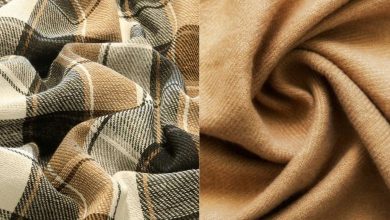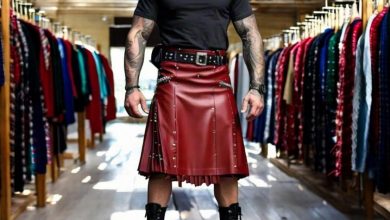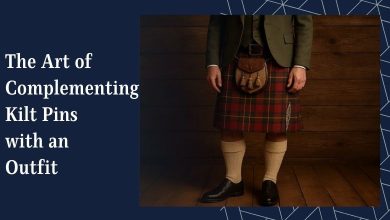Scottish Dirk: History, Legacy in Culture, and More
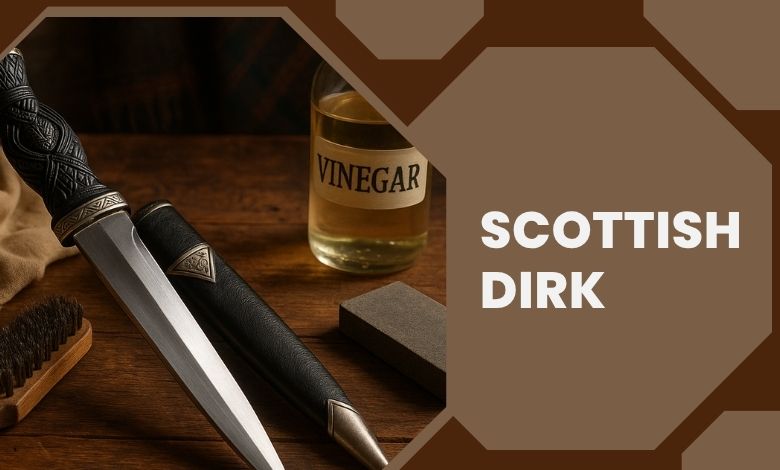
The Scottish dirk is a long-bladed thrusting dagger which is also an essential part of traditional Scottish Highland dress. Some people confuse it with Scottish knives, which is just a misconception. It is a traditional weapon that primarily serves as a decorative ornament today. However, it was a protection arm in the past. This discussion revolves around the Scottish dirk from its history, symbolism, and design to its comparison with Sgian-dubh. So, there is no reason to linger, let’s start with our interesting topic.
Table of Contents
ToggleThe History and Evolution of the Scottish Dirk
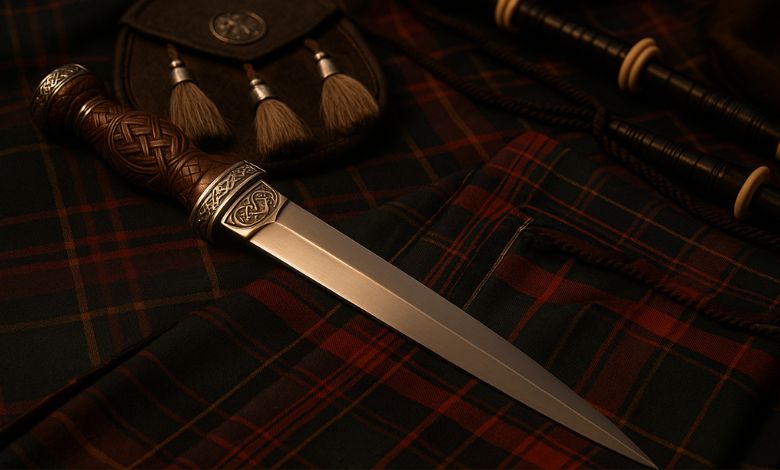
The dirk’s design makes it simple to identify. It typically features a long and straight blade with a decorative handle. Dirks are usually silver-plated and carved from wood. There are also some with Celtic designs. The dirk is nevertheless an effective symbol of Scotland’s rich history even if it is no longer employed in combat.
The long history of dirks makes them a classical part of Highland attire. Highland soldiers were the first to carry it. Introduced to Scottish dress in the 16th century but it gained popularity in the 17th century. The Scottish dirk acted as a sign of pride and respect from day one. Moreover, other than being simply a weapon, it was an integral element of everyday life as well.
The dirk evolved into more than just a combat weapon. It began to stand for courage, loyalty, and Scottish national pride. It is frequently used with traditional Highland dress for formal occasions like ceremonies. After many centuries of becoming a part of Scottish attire, it is still very much a part of Scottish culture.
Parts and Styles of the Scottish Dirk Explained
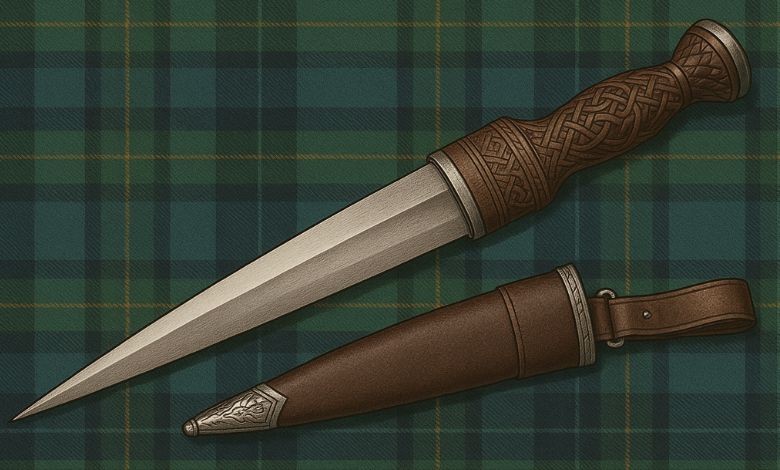
No matter what part of the kilt outfit it is, understanding it is very important. Most kilt accessories have various parts with distinct designs. Scottish dirk is not an exception in this case and comprises 3 main components including blade, hilt, and scabbard. Have a look at their details downward:
Blade: The dirk’s blade is its primary part and it is intended for slashing or stabbing. Usually long and tapered, it provides efficient thrusting.
Hilt: The hilt, being a practical part of the dirk, helps to ensure a firm grip. It is the portion of a dirk that is grabbed. Several materials such as wood, horn, or other substances create them. Therefore, a handle is designed for stabbing and slicing because it is long enough to be held in both hands.
Scabbard: The scabbard, which might be made of leather or wood, protects the blade. Usually embellished, it could feature fittings to fasten the dirk to a belt.
How to Wear a Traditional Scottish Dirk with Highland Dress
People believe wearing a Scottish dirk and a Sgian-dubh to be the same but it’s a misconception. Let’s explore how to wear a dirk and the first step should be to ensure that it is securely sheathed. The scabbard may be fastened with a strap on a belt. Keep the fitting neutral, without it being too tight or too loose. To confirm your comfort and safety, just make sure it’s securely attached.
The Cultural Significance of the Dirk in Highland Dress
The Scottish dirk has great cultural significance in Highland attire. It is not an everyday part of attire but people wear it rarely, especially on formal occasions. The role of Scottish dirk is to demonstrate pride and tradition in regimental ceremonies, parades, and weddings. Even though not used for a longer duration in combat, it still remains a significant aspect of Scottish culture. Above all, it adds to the antique appeal of the Highland ensemble and completes it as well.
Scottish dirk has strong familial and personal importance and is frequently passed down through the generations. It is still regarded as a genuine symbol of respect and honor in Scottish ceremonial attire and culture. It connects the past and present in a single, classic work of workmanship, linking Scotland’s tumultuous yet proud history to modern tradition.
Basic Care and Maintenance of a Scottish Dirk
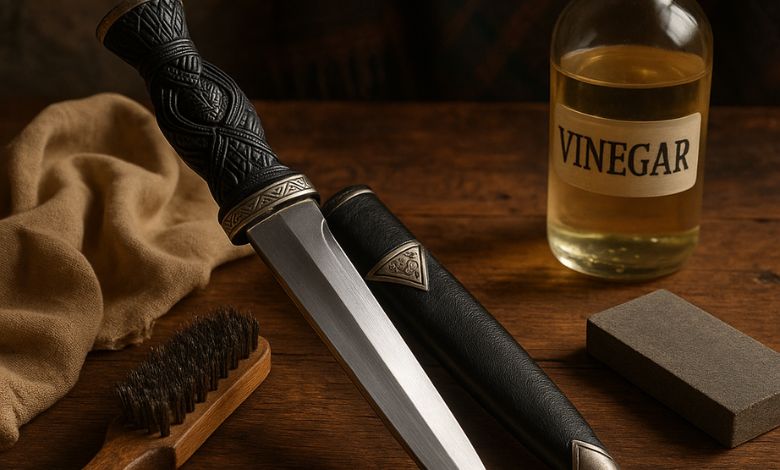
Wearing kilts has some specific protocols while one of them is to keep it clean and fresh. Remember, every type of men’s kilt and their parts have particular caring tips and so is true to the traditional dagger of Scotland. One must follow the below-given tips to keep it effective:
- Make sure to clean the blade of your dagger after every use. Be careful while clearing and use a soft cloth. Gently wipe the blade to get rid of any moisture or grime.
- Rust is common to spot on blades and it can affect your dirk too. So, if you notice any rust, remove it using a soft iron brush and a cleaning solution such as vinegar or baking soda.
- Your dirk’s handle may be made from wood, leather, or other materials. Use appropriate cleaning agents designed for those specific materials. So, make sure you use the right cleaning supplies to maintain its charming visuals.
- Maintain the blade’s cutting edge by frequently sharpening it. If you are an experienced person, it might be a plus point. Otherwise, ensure consulting professional service providers.
- Proper storage of dirks helps you get rid of rust and corrosion. So, confirm to store the dirk in a cool, dry place.
- Don’t keep the dirk in its leather sheath for long since scabbards can accumulate moisture and cause corrosion.
Modern Craftsmanship of Scottish Dirks
The creation of Scottish dirks is an interesting point. Therefore, the craftsmanship technique fascinates many people and impacts the choice of wearers. People who want to stay connected to their traditions often prefer daggers made with traditional hand-forging techniques. They use traditional leaf steel to make blades while blackwood for handles having Celtic designs.
In contemporary times, situations have changed significantly. A single person does not make a dagger while advanced metallurgy tools have grabbed the responsibility of making high-quality blades. Similarly, designs on handles are not hand-made but computer-aided designs (CAD) have become popular. Moreover, the usage of synthetic materials instead of original chemicals peaks today.
Scottish Dirk in Military and Ceremonial Use Today
Scottish dirk played an unforgettable role in Scottish military history and became a sign of officer’s rank. Once these traditional Scottish weapons were for every military person but became specific to those who showed a high level of bravery.
These days, they are frequently spotted in royal armies but are not actual fighting weapons. The military uses them as ceremonial items. It still has great ceremonial and symbolic significance even if it is no longer the main weapon in combat situations. Officers, drummers, and pipers of Scottish Highland regiments wear them, mostly for ceremonial reasons.
Dirk vs. Sgian Dubh: What’s Top Choice Today?
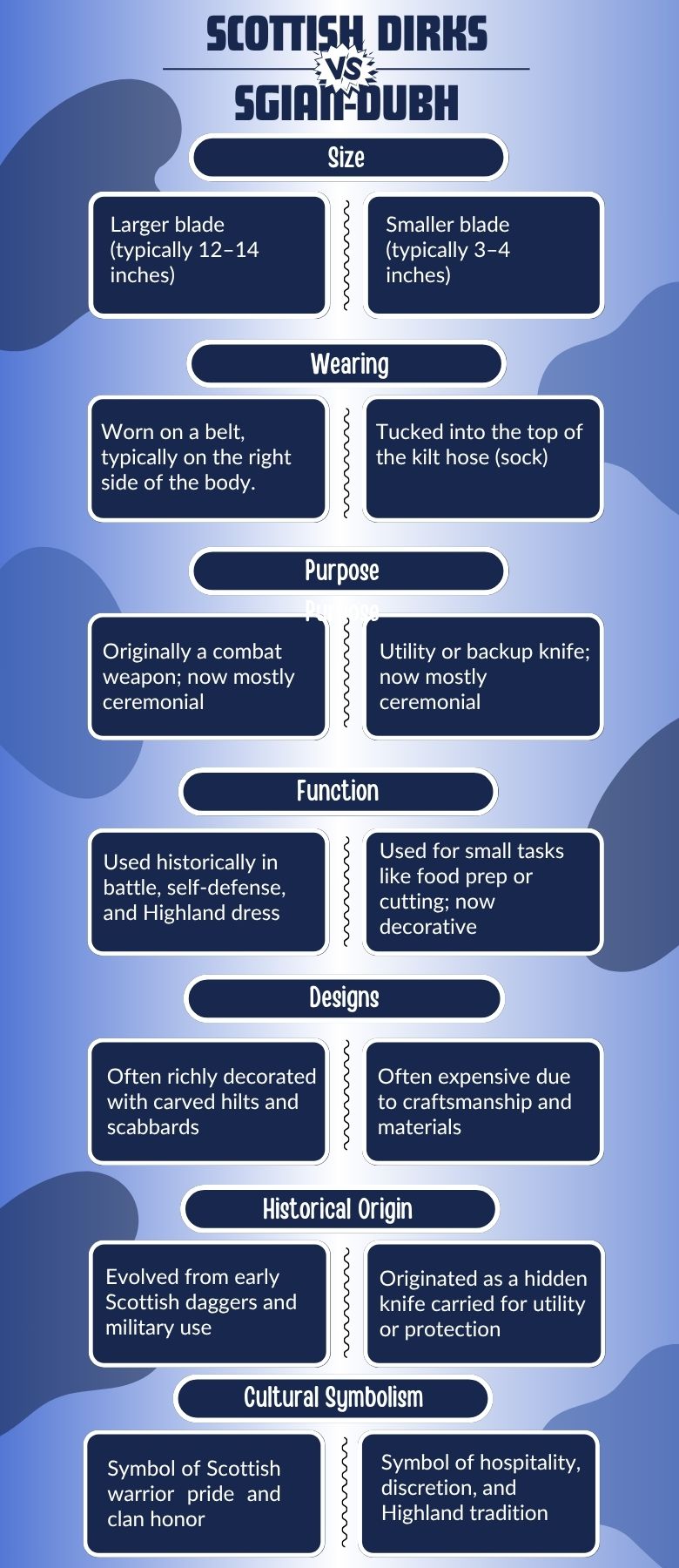
We have already mentioned a misconception of considering the Scottish dirk and Sgian-Dubh, the Scottish knife, to be the same. It’s time to unveil the reality and let them know about their differences to solve this mystery. Their differences primarily exist in three ways: size, wearing, purpose, and functions.
| Features | Scottish Dirks | Sgian-Dubh |
| Size | Larger blade (typically 12–14 inches) | Smaller blade (typically 3–4 inches) |
| Wearing | Worn on a belt, typically on the right side of the body. | Tucked into the top of the kilt hose (sock) |
| Purpose | Originally a combat weapon; now mostly ceremonial | Utility or backup knife; now mostly ceremonial |
| Function | Used historically in battle, self-defense, and Highland dress | Used for small tasks like food prep or cutting; now decorative |
| Designs | Often richly decorated with carved hilts and scabbards | Typically features a black handle (hence “dubh” meaning “black” |
| Historical Origin | Evolved from early Scottish daggers and military use | Originated as a hidden knife carried for utility or protection |
| Cultural Symbolism | Symbol of Scottish warrior pride and clan honor | Symbol of hospitality, discretion, and Highland tradition |
Choosing the Right Scottish Dirk for Your Outfit
When choosing a Scottish dirk, it’s important to consider a few points like the formality level of the event, safety, material of the dirk, and more. So, we made a list of tips to opt for the right one for you.
Consider Event’s Theme: While often reserved for formal events, a dirk can also be appropriate for certain semi-formal occasions. The thing that matters here is choosing the right level of ornaments attached.
Ensure Safety: Some cheap brands do not prioritize quality which compromises safety. Always check if the dirk comes with a secure sheath and rounded edges, especially if it’s for decorative or costume use.
Material Matters: Traditional dirks are usually made from high-carbon steel or stainless steel. If you are looking for authenticity, go for hand-forged steel blades with hardwood or horn handles.
Match with Your Attire: Choose a dirk that complements the colors and style of your kilt and jacket. A well-matched dirk enhances your overall look without drawing too much attention.
Check Legal Regulations: In some places, carrying a dirk even as part of Highland dress may be restricted. Always confirm local laws to avoid any inconvenience at the event.
The Utility Kilt: The Ideal Platform to Buy Scottish Dirk
Now that you know the different aspects of Scottish dirks—from their origins to their modern evolution and how they are different from Sgian-dubh. It’s time to buy a suitable product for you and the selection of a reliable brand must be your priority here. If it is so, there is nothing to worry about since The Utility Kilt provides excellence in every kilt and its accessories. So, visit our online brand right now and order what you want.
FAQs about Scottish Dirks
Is dirk legal in Scotland?
Yes, keeping a dirk is legal in Scotland but you must have a valid reason to do so. There is no prohibition to attach it with your Highland dress.
How Scottish dirks are different from daggers?
A dirk is a long-bladed thrusting dagger of Scottish origin that traditionally connects to Highland troops. A dagger, at the same time, is a broad word for a short, thrusting weapon.
How long is a Scottish dirk?
Do women use traditional dirks with their outfit?
Yes, women can keep dirk with them, specifically for formal events. Therefore, women’s dirks can be smaller in size.
What are the different types of Scottish dirks?
Many people believe there is only one type of Scottish dirk, but there are actually several varieties:
- Rampant Lion Sgian Dubh
- Damascus Dirk
- Early Dirks
- Clan Macleod Dirk
